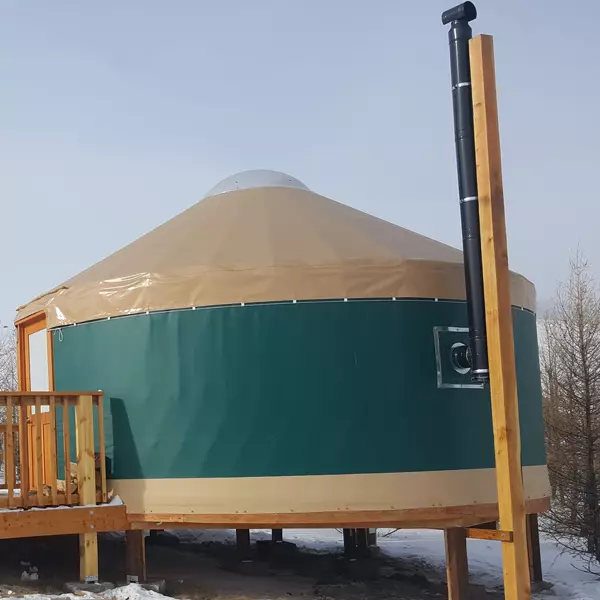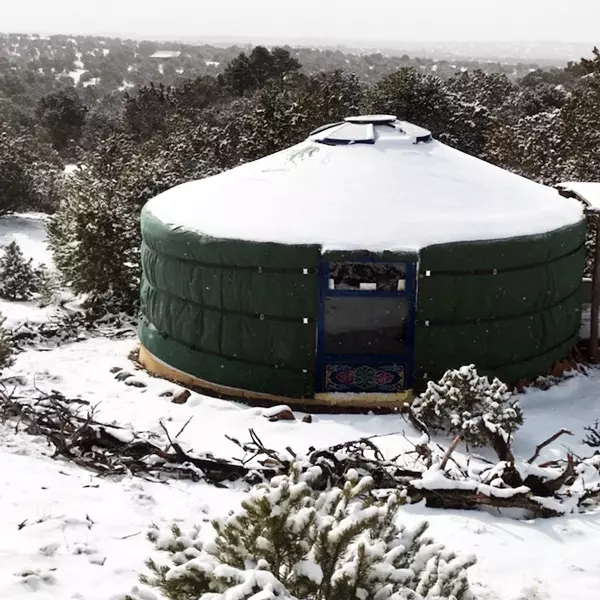The modern yurts, produced mainly by U.S companies, take the concept of yurt structure from Mongolian yurts. But they are very different from traditional Mongolian yurts in other aspects. They are hardly portable, use lots of synthetics, and have the feeling of “manufactured” structures.
Mongolian yurts have shorter wall heights than modern yurts. Higher walls mean you do not have to bend down when you enter or exit the yurt if you are tall. This also means larger cubic space inside the yurt requiring more energy to heat and cool it down. Short walls in a Mongolian yurt does not mean you will have to be bent down the whole time you are inside. Most of the time, you will be away from the wall and do not have to be bent down even if you are 6ft or taller. Original Yurts have about 8′ (20cm) higher walls than the “traditional” Mongolian yurts.
The skylight (crown) in modern yurts is smaller, allowing for only a small amount of natural light. A small skylight also means fewer rafters spaced far apart, especially towards the wall. This makes hard to put any soft fabric like felt the roof for insulation. In most cases, you can see skeleton of modern yurts from outside even with the cover on, because the cover is pulled down between the rafters. A Mongolian yurt has a larger skylight allowing for much more rafters spaced closely. This enables putting layers of soft fabric for insulation. More rafters make the yurt sturdier; someone lightweight to go on top of the roof of a Mongolian yurt and do maintenance and cleaning when necessary.
Because of the small skylight, modern yurts do not have to have pillars (central posts) supporting the skylight. The pillars are required for Mongolian yurts 19ft (5.8m) or larger. The skylight design in modern yurts does not allow locating the stove in the center of the yurt. This is possible for a Mongolian yurt with the smoke pipe going through the skylight. Our Original Yurts have preinstalled pipe flashing accommodating smoke pipes of various diameters.
Modern yurts have only radiant barrier insulation, while Mongolian yurts have felt insulation, which has better insulating properties when chosen appropriately. Original Yurts have both felt and radiant barrier insulation.
Outer covers for modern yurt are usually made of PVC, which lasts much longer and easier to keep clean. Outer cover for a Mongolian yurt is usually made of cotton canvass in white color, which tears down easily, and needs to be changed every 1-3 years. Original Yurts now have PVC outer cover, same as in the modern yurts.
Perhaps the most important difference between the two types of the yurt is that a Mongolian yurt has a character; it gives you a feeling of being in an artistic, unique, and natural space.
Keep reading below to know differences between Mongolian and Moderns yurts in some other practical aspects.
Most modern yurts have two layers of cover: a) reflective barrier insulation, and b) polyvinyl cover for the roof and wall. These are both non-organic material and have relative hard surfaces. Because of this, modern yurts are quite noisy, especially when they are used in areas with heavy rainfall. “…Nothing prepared us for the sound of an afternoon deluge. It sounded like we’d parked the yurt under Niagara Falls. The torrent was so loud that if we were watching a movie, we’d have to turn it off. The volume didn’t go high enough to override the cascading rain…“ (page 87, “A Year in a Yurt, by Adam & Autumn Raven).
On the contrary, Mongolian yurts have felt layer(s), waterproof canvass, and exterior canvass, which are all-natural soft materials. Felt provides great insulation from only heat and cold, but also from noise, making Mongolian yurt far superior in this aspect.


All modern yurts use radiant barrier insulation. Insulation in modern yurts are so thin that you can see the wood frame from outside (picture of a Modern yurt, above). Some producers of the modern yurts make claims such as radiant barrier it is used by NASA, and that it offers a high level of insulation as measured by “R” value. However, because the vinyl/polyvinyl material used in the cover absorbs heat, the modern yurts can be very hot.
“…We started looking around for wooded lots. Moving out of the sun and its potent summer heat, hot enough to melt candles in the yurt, was a priority…”. (page 168, “A Year in a Yurt, by Adam & Autumn Raven“).
Heat/cold can get inside the yurt either by a process called thermal radiation, or by a process called conduction. Radiant barriers provide insulation mostly when heat/cold is transferred by thermal radiation. Place one side of the radiant barrier insulation material on a very cold surface such as a pack of ice. You will soon feel in the palm of your hand the other side of the radiant barrier to cool down. That is because the radiant barrier material itself is acting as an agent of transfer allowing the shift of energy by conduction.
In contrast, wool felts in Mongolian yurts, which are as thick as 1 inch and provides superior insulation when the heat is transferred by conduction. The white color of the felt and the exterior cover help reduce heat transfer by thermal radiation. In order to increase insulation capacity for yurts to be used in very hot areas, we offer radiant barrier insulation in addition to the felt cover as an optional feature. With these two layers on, our Mongolian yurts have the best insulation capacity among its peers.

In most modern yurts, the stove has to be located in near the wall as they have openings for the stovepipe in the wall. This results in uneven heat distribution.
“…Having the wood stove over by the wall creates a hot side and a cold side of the yurt. It is harder to get the heat over to the cold side… I would rather have stove centrally located so the heat spreads evenly from the center to the walls…“, (page 63, Practical Yurts, by Steven W. Hatch).
In Mongolian yurts, the wood-burning stove is located in the right middle of the yurt, and the stovepipe goes through the crown (skylight) so that the heat is evenly distributed in the yurt.
©
2024
Ashid Ger LLC